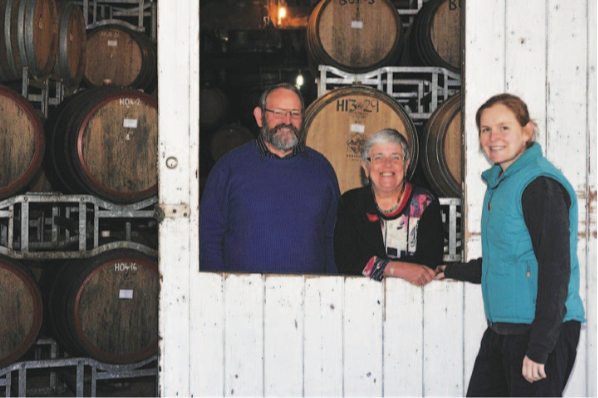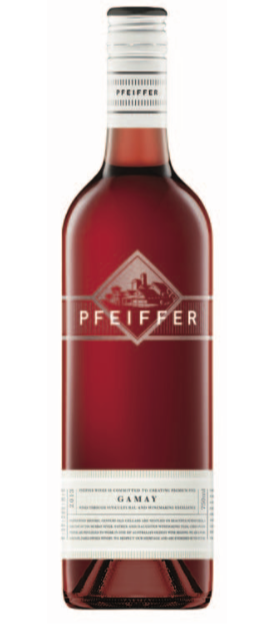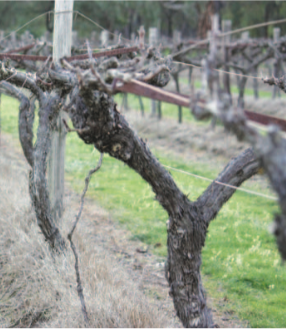By Sonya Logan
First published in the May/June 2014 issue of the Wine & Viticulture Journal
Pfeiffer Wines will produce its 30th consecutive vintage of Gamay this year and, in that time, the wine has become a ‘pflagship’ – as it is referred to on the winery’s website – for the family-owned Rutherglen producer.

 Chris and Robyn Pfeiffer didn’t have the option of choosing to grow Gamay when they purchased their Rutherglen property from Seppelt back in 1984. The variety was among some 20 others that Seppelt had been growing in what the Pfeiffers now call their Sunday Creek Vineyard. But, given the wine that they’ve produced from those vines has become its flagship, they are no doubt rather thankful for the inheritance.
Chris and Robyn Pfeiffer didn’t have the option of choosing to grow Gamay when they purchased their Rutherglen property from Seppelt back in 1984. The variety was among some 20 others that Seppelt had been growing in what the Pfeiffers now call their Sunday Creek Vineyard. But, given the wine that they’ve produced from those vines has become its flagship, they are no doubt rather thankful for the inheritance.
Planted by Seppelt in 1976, the Gamay vines were yet to yield a crop when the Pfeiffers took over the vineyard, for reasons no-one quite knows. But, crop they did in 1985 – and have done so every year since – meaning Chris Pfeiffer, who hadn’t worked with Gamay previously, had to quickly research the variety.
“I knew that Gamay was used to make Beaujolais, so I set about finding out how that was made,” Chris recalls. “In 1986, we released a Gamay Cabernet Sauvignon, but that’s only because we didn’t have enough Gamay to make it on its own. We’ve made a straight Gamay ever since.
“From the start we made Gamay using carbonic maceration to make a lighter, fruitier style. Back in the mid ‘80s, there weren’t a lot of lighter reds being produced by Australian wineries. I believe Sorrenberg and Scarpantoni were the only other wineries producing Gamay.
And there wasn’t much Pinot Noir being produced back then either, so Gamay was a niche for us and helped put us on the map.”
Pfeiffer Wines still makes its Gamay using carbonic maceration, although Chris admits it’s not as sweet as when it was first produced, and is a little heavier in tannin, but it is nonetheless a fruity feast.

In the early 1990s, the Pfeiffers planted an additional four acres of Gamay in another section of its Sunday Creek vineyard, which is bordered by three bodies of water: the Murray River lies to the west, Sunday Creek to the north and Lake Moodemere to the south.
“Sunday Creek is one of the coolest sites in Rutherglen and it behaves like a cooler site to a degree,” explained Chris and Robyn’s daughter and winemaker Jen Pfeiffer. Lying 135 metres above sea level and in a bit of gully, the site features sandy soil over river gravel.
“The old vines in the Sunday Creek Vineyard are on a wide T trellis and yield quite low – around one tonne to the acre.
The vines are not vigorous being so old, so they don’t grow a lot of canopy. We do our best to build up canopy through irrigation to avoid the fruit getting too much sunburn and raisining.
“The Gamay is usually the first or second red that we harvest in that vineyard; if the season is early, we’d harvest it around the third week of February, and if it’s late we’d harvest it around the third week of March.”
“The younger Gamay vines are planted on a single wire and have an additional foliage wire. It’s clearly a very different clone to the older vines. The bunches are different – the old vines have tight bunches, smaller berries, smaller bunches. The newer vines have bigger berries and bigger bunches,” Jen said.
“The two plantings taste quite different too. The wine from the older vines is more earthy. It can sometimes be a little bit gamey, but in a good way, and smells of truffle and dark cherries. The younger vines make wine with strawberry and raspberry fruit characters. It’s a lot fresher, with more summer berries.
“In our view, the older vines always produce the better wine. Perhaps that’s also partly because of the viruses that we know are in that block,” Jen said, explaining that leafroll virus has been known to be in the vineyard for some time, and last year the presence of Botryosphaeria was confirmed too.
“Over the past couple of seasons, we’ve been taking cuttings from the old vines and grafting them onto the newer vines. We’ve been doing a couple of rows a year, but now that we know about the Botryosphaeria in the older plantings, we might have a rethink about whether we continue that grafting over. We’ve still got about two-thirds of the block to do.”
Jen said based on the stark contrast between the two clones of Gamay in the Pfeiffer vineyard, attention to clonal selection was important if considering to plant Gamay. Keeping canopies light, where necessary, and crop loads low was also advisable once the vines are in the ground.
“Our young vines can be highly vigorous. They always have plenty of canopy so the extra foliage wire helps manage that. In years when the vines have been too vigorous, the intensity of the fruit flavours has not been as good.
And, in some seasons we’ve dropped fruit at veraison to help balance the vines too,” Jen said.
GAMAY

By Peter Dry, Emeritus Fellow, The Australian Wine Research Institute
Background
Gamay Noir, or just plain Gamay (gam-MAY) as it is most commonly known, is a natural progeny of Pinot and Gouais Blanc. Therefore, it has at least 20 siblings, including Chardonnay. It arose somewhere in Burgundy—the first record there was at the end of 14th century. Numerous spellings have been used, e.g. Gamey, Gamé, Gamez, until the current form was adopted in 1896. There are mutants with coloured pulp such as Gamay Teinturier de Bouze—this is why Gamay is sometimes known as Gamay Noir à Jus Blanc. There are many synonyms including Bourguignon Noir and Petit Gamai. Globally there were 32700 ha in 2010 (down 14% from 2000), 93% in France of which approximately two-thirds is in Beaujolais and environs – there is little else grown there as far as red grapes are concerned. Most Beaujolais wine is 100% Gamay Noir. There is also some in the Cote d’Or but the area is small because it has always been considered to be inferior to Pinot Noir—in fact, there have been several attempts in the past to limit the plantings for this reason. It is planted widely across the Loire, particularly in Loir-et-Cher, and also in Savoie where it is the main red variety. In Switzerland it is the second most important red after Pinot Noir. There are small areas in eastern Europe where it has been confused with Blaufränkisch—in part due to the use of synonym Gamé in some countries. There is little grown in the New World other than small areas in Oregon, Canada, New Zealand and South Africa. In Australia, the first introductions from California turned out to be Pinot Noir (introduced as ‘Gamay Beaujolais’ in 1962) and Valdiguie (introduced as ‘Napa Gamay’). Subsequently, clones of true Gamay have been introduced since the early 1970s; and there are now at least 12 clones here. Soon after the initial introductions of true Gamay, a single vine of it was discovered in an old mixed vineyard at Great Western—so it was probably introduced more than one hundred years ago. The total area in Australia is unknown; there are currently at least 27 wine producers, mainly in cool regions in Vic. and Tas. In 2015 there were 4 ha in SA.
Viticulture
Budburst and maturity are early. Vigour is low to moderate with semi-erect growth habit. Bunches are small to medium, well-filled to compact with medium berries. Yield is moderate to high. The large crop may inhibit shoot growth. Pruning is generally to short spurs as a means of yield control. Although susceptible to spring frost damage due to early budburst, it has good recovery due to very fruitful secondary buds. It is susceptible to sunburn and fungal diseases, particularly bunch rot due to its compact bunches.
Wine
Fruit has ripe berry and spicy characters giving light bodied savoury wines with firm acid and low tannin. Descriptors include strawberry, red currant and herbal. Wines have good consumer appeal and are not usually aged in bottle. Carbonic maceration is commonly used in Beaujolais.




















